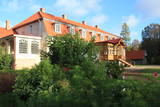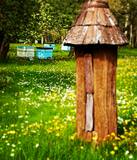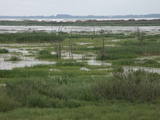| Нo | Название | Описание |
|---|---|---|
|
Interesanta dabas izziņas taka, kurā izvietoti informatīvie stendi, kas stāsta par dažādiem pļavu biotopiem – sausām, palieņu un parkveida ozolu pļavām un tās iemītniekiem. Pļavas nogana dzīvei savvaļā pielāgotie mājlopi. |
||
|
1339. g. Livonijas ordeņa mestrs (no 1328. – 1340.) Eberhards fon Monheims pašu zemgaļu 1286. g. nodedzinātās pils vietā uzceļ jaunu - mūra pili. To sešus gadus vēlāk nodedzināja lietuviešu karaspēks. Pili gan atjaunoja Kurzemes hercoga Ketlera valdīšanas laikā, taču Ziemeļu kara laikā - 1701. g. to atkal noposta zviedru karapulki. Līdz mūsdienām ir saglabājusies tikai no laukakmeņiem celtās pils sienas atliekas. |
||
|
Самое большое населенное место на юго-востоке Латвии, которое с юга омывается водами Даугавы, одновременно являющейся Латвийско-Белорусской границей. Граница государств проходит по середине реки. Пиедруя состоит из двух частей – Пиедруя и Александрова, которые разделяет центральная улица (дорога V 631). Пиедруя образовалась как «заречная» территория существующего на левом берегу Даугавы города Друя. Обе части в 17-м веке были собственностью рода магнатов Сапег Великого княжества Литовского. Малоэтажная застройка Друи с разрушенной церковью хорошо просматривается с берега Пиедруи. Пиедрую и ее окрестности стоит обойти пешком, так как малоэтажная деревянная застройка местами напоминает виденное в этнографических музеях под открытым небом. Пиедруя благоустроена, между двумя церквями разбит живописный сад. Со значимыми объектами – двумя церквями и Даугавским камнем знакомит Пиедруйская тропа. В Александрова находится гостиница «Пиедруя», предлагающая особый туристический продукт – вечеринки в латгальском, русском и белорусском стилях. Перед отправлением в Пиедрую необходимо оформить разрешение для пребывания на приграничной территории. Пост пограничного контроля находится в Пиедруе, на берегу Даугавы, где еще сравнительно недавно действовала одна из Даугавских переправ. |
||
|
Старинный комплекс поместья Олеру начал создаваться в 17-м веке. Изначально поместье состояло из деревянного господского дома и хозяйственных зданий. Новый центр поместья построили в конце 18-го века в стиле раннего классицизма. После аграрной реформы в жилом здании поместья создали основную школу, а в советское время (до 70-х годов) – вспомогательную школу для отстающих детей. Замок поместья Олеру пострадал в пожаре 2000-го года, после чего были начаты работы по восстановлению. Большой вклад внесло и вносит общество «Поместье Олеру». Господский дом знаменит настенными росписями в стиле раннего классицизма, из которой уникальной считается т.н. «Галерея картин». Рядом с господским домом находится живописный парк. Поместье Олеру знаменито концертами камерной музыки. Недалеко от поместья находится болото Олеру с мостками и смотровой вышкой. |
||
|
Красивый сельский двор с экологической философией управления и ~ 300 пчелиных семей. Для посетителей построен магазинчик и дегустационный зал. Покупка меда разных цветов, цветочной пыльцы, прополиса, пчелиного хлеба, восковых свечей и сувениров. Дегустация продуктов пчеловодства (в т.ч. медового вина) и экскурсия. |
||
|
В хозяйстве выращивают и собирают ~ 80 лекарственных растений - мяту, ноготки, ромашку, душицу, зверобой, горькую полынь, овес, чабрец, подорожник, яруткуполевую, таволгу и др. Хозяин проводит экскурсию, рассказывает о лечебных растениях и их применении. Осенью предлагает приобрести лечебные растительные чаи. |
||
|
The Lake Lubāns depressions which are alongside the lake’s western and south-western parts feature little-changed forests and swamps, where many rare and protected birds nest. Many uncommon and protected habitats are in the region.
|
||
|
This section of the Baltic Coastal Hiking Route is a comparatively short hike across a beautiful sandy beach, the coastal side of which is bounded by brightly colored pine forests with spectacular dunes and dams of dunes. To get from the beach to Carnikava, the Baltic Coastal Hiking Route will take you through a forest via a promenade. Then it takes a stroll around the Old Gauja River via a levee and reaches the pedestrian bridge over the Gauja River. Both as you start and end the hike, it is nice to sit in one of the pubs and summer cafés located on Vecāķi beach and in Carnikava. |
||
|
This is the thickest and tallest common ivy in Latvia. It is in the park of the Zentene Estate, opposite the mansion (which is now a school).
|
||
|
Bioloģiskā saimniecība nodarbojas ar Irbeņu ogu audzēšanu un dažādu to produktu ražošanā kā pulverus, sulas, tinktūras, eļļas, sejas maskas un kapsulas. Irbene ir vērtīgs ārstniecības augs, kur izmantojamas ir pilnīgi visas tā daļas – lapas, ogas, sēklas, stumbrs, miza, sakne un ziedi. |
||
|
One of the most popular areas of uncovered sandstone in Latvia, known for its unusually smooth and sound-reflecting cliff wall (around 12m in height). Located on the right bank of the Salaca river, there is a place for tenting. A fun experiment is to stand in various closes opposite the cliff and to speak quietly. The echo will be heard either by the speaker or by people who are standing elsewhere. Located in the Salaca valley nature park and the Skaņaiskalns park.
|
||
|
В процессе выпечки хлеба «Лачи», популярного в Латвии и за ее пределами, применяют дошедшие с древних времен и сохраненные мастерами знания и умения. Здесь в дровяных печах пекут хлеб, используя только качественное сырье, натуральную закваску и опару. Ржаной хлеб выпекается из грубой и обдирной ржаной муки. Тесто бродит в деревянных квашнях и вымешивается вручную. За соблюдением традиций выпечки хлеба следят два мастера-пекаря и четверо подмастерьев.Здесь можно отправиться на экскурсию, сделать и выпечь буханку хлеба, подкрепиться в прекрасном кабачке и купить произведенную здесь продукцию. Латышская кухня: Крем-суп из боровиков, разные горячие блюда в горшочках, хлебный суп, «Десерт булочника». |
||
|
Here you will learn about home-based manufacturers, farms, companies and others in Latgale that produce various dairy products such as milk, yogurt, cottage cheese, cheese, ice cream, etc. Start in Preiļi, which is known as Latvia’s cheese capital. The route passes along the Teiči nature reserve, with a viewing tower at the side of the road, also crossing Lubāna wetlands, which are of European importance for environmental protection. Drive on to Rēzekne (churches, a monument to Māra of Latgale, “Gors,” “Zeimuļš”, etc.). Nature lovers will love the Rāzna National Park with Lake Rāzna, Mākoņkalns hill and the master ceramicist Evalds Vasiļevskis. From Dagda, head to Aglona, which is a centre for Roman Catholic worshippers, and Lake Rušons before returning to your starting point. |
||
|
Atrodas netālu no Biksēres muižas, blakus muižas parkam. Ozolkalna klēts saimniece Līga Kuba aušanas prasmes pirms pāris gadiem apguvusi Sarkaņu amatu skolā. Šeit radusies iecere par privātas aušanas darbnīcas izveidi, kas arī īstenota. Saimniece savas aušanas prasmes nodod jebkuram interesentam. Apmeklētāji var iegādāties šeit darinātos suvenīrus. |
||
|
One of the three highlands of Southern Estonia with scenic hills and beautiful sights. In its center lies the bay-rich Lake Pühajärv (translating from Estonian - Holy Lake). |
||
|
На ферме выращивают альпаков, лам, верблюдов, осликов, страусов, голландских козлят, шиншилл и кроликов. В присутствии хозяев животных можно покормить, погладить, сфотографироваться вместе с ними. На ферме оборудованы беседки. В кафе можно угоститься кофе и закусками. Также можно приобрести сувениры и изделия из шерсти альпаков. |
||
|
Atrodas Kraujā – Daugavas ielejas krasta malā un nogāzēs. Atrodama informācija, ka šajā vietā Livonijas kara laikā atradusies krievu karaspēka nometne. Muižas nosaukums cēlies no vācu Hof zum Berg – „Kalnu muiža”. Pēdējie muižas īpašnieki līdz 1. pasaules karam bija grāfu Šahno dzimtas pārstāvji. Viens no tiem – Marians Šahno 1910. gadā uzceļ muižas pili, kas bija būvēta eklektisma formās. Daļēji nojaukta tā pārdzīvo padomju laikus, līdz 2002. gadā nodeg. Līdz mūsdienām saglabājušās vien ēkas sienas, kuras slēpj biezs augājs. Var tikai iedomāties, kādi skati šeit kādreiz pavērušies uz Daugavas ieleju! Muižas parks ir vietējo iedzīvotāju pastaigu vieta. |
||
|
Построено во время первой Независимой Латвии и сохранило свои функции до наших дней. Находится на улице Тукума, 30. С 1940 года на почте действовала автоматическая телефонная централь. Почта уже не работает, и здание можно осмотреть снаружи. |
||
|
Кроличья ферма (11 пород, примерно 200 голов), посетителям которой предлагают экскурсию с осмотром кроликов и консультации по выращиванию кроликов и селекционной работе. Интересующиеся могут приобрести животных разных пород. |
||
|
Расположен в старом здании школы, ул. Сколас, д. 11А. В музее представлены гостиная и кухня суйтов, литургические костюмы католических священников, меняющаяся экспозиция в выставочном зале и история формирования и нынешние дни этнографического ансамбля «Суйту сиевас» (“Suitu sievas”). Специальное предложение музея - выступления суйтских жен, суйтских мужей и суйтских дудочников. |
||






















